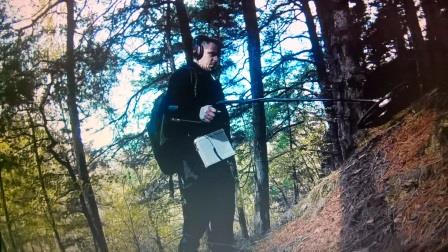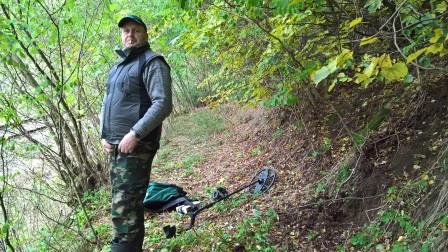Curiosity fall of the meteorite in the Czech Republic.
Čistěves - Kralovehradecky
Shooting for a family house solved!
Source and image: Police Czech Republic
July 2018 Lunar eclipse
from Italy
Expedition MeteoritesWorld 2021.
- March 2021 Czech Republic-Příbram
- September 2021 Poland-Morasko
- September 2021 Czech Republic-Vícenice
Morasko Meteorit nature reserve north of Poznan in Poland
There are seven impact craters that were created by the impact of the iron asteroid about 5000 years ago in the central ice glacier moraines that created the Mount Morasko and the craters are located in its northern part. The renown of the site makes a huge amount of iron meteorites found, ranging from gram samples to a 300 kilogram sample found in 2012.
METEORITES IN THE CZECH REPUBLIC
-
Iron
- Elbogen - 1400 Karlovarsky, Czech Republic - Iron, IID - 107 kg
- Odranec - 1619 Vysocina, Czech Republic - Iron, ??? LOST *
- Bohumilitz - 1829 Jihocesky, Czech Republic - Iron, IAB-MG 59 kg
- Braunau - 1847 Kralovehradecky, Czech Republic - Iron, IIAB 39 kg *
- Alt Bela - 1898 Moravskoslezsky, Czech Republic - Iron, IID 4 kg
- Sedcany - 1900 Stredocesky, Czech Republic - Iron 20 g
- Tepla - 1909 Karlovarsky, Czech Republic - Iron, IIIAB 17 kg
- Vicenice - 1911 Vysocina, Czech Republic - Iron, IID 4.37 kg
- Opava - 1925 Moravskoslezsky, Czech Republic - Iron 14.3 kg
- Chlumec - 1993 Kralovehradecky, Czech Republic - Iron, ungrouped 3 kg *ᴬ
-
Mesosiderite
- Potucky ( Breitenbach) - 1861 Karlovarsky, Czech Republic - Mesosiderite 10.5 kg *ᴮ
-
Achondrite
- Stannern - 1808 Vysocina, Czech Republic - Eucrite-mmict 52 kg *
-
Chondrites
- Ploschkovitz - 1723 - Ustecky, Czech Republic - L5 / 39 g *
- Tabor - 1753 - Jihocesky, Czech Republic - H5 / 7.54 kg *
- Lissa - 1808 - Stredocesky, Czech Republic - L6 / 12.8 kg *
- Zebrak - 1824 Stredocesky, Czech Republic - H5 / 2 kg *
- Wessely - 1831 - Jihomoravsky, Czech Republic - H5 / 3.75 kg *
- Blansko - 1833 - Jihomoravsky, Czech Republic - H6 /470 g *
- Tieschitz - 1878 - Olomoucky, Czech Republic - H/L3.6 / 28 kg *
- Sazovice - 1934 - Zlinsky, Czech Republic - L5 / 412 g *
- Zlin - 1939 - Zlinsky, Czech Republic - H4 / 3.3 g
- Pribram - 1959 - Stredocesky, Czech Republic - H5 / 5.56 kg **
- Usti Nad Orlici - 1963 - Pardubicky, Czech Republic - L6 / 1269 g *
- Suchy Dul - 1969 - Kralovehradecky, Czech Republic - L6 / 815 g *
- Moravka - 2000 - Moravskoslezsky, Czech Republic - H5 / 633 g **
- Benesov (a) - 2011 - Stredocesky, Czech Republic - LL3.5 / 9.7 g **
- Benesov (b) - 2011 - Stredocesky, Czech Republic - H5 / 1.54 g **
- Zdar nad Sazavou - 2014 - Vysocina, Czech Republic - L3 / 45 g **
- Hradec Kralove - 2016 - Kralovehradecky ,Czech republic - LL5 / 135 g **
* observed fall
** with pedigree
_____________________________________________________________________________________________________________
Additional data
*ᴬ Whereas Meteoritical Bulletin no documentation meteorite Chlumec, presenting here.
Title:
Mineral chemistry of inclusions in the new iron meteorite Chlumec
Authors:
Skala, R.; Fryda, J.; Bukovanska, M.
Affiliation:
AA(National Museum, Prague, Czech Republic), AB(National Museum, Prague, Czech Republic), AC(National Museum, Prague, Czech Republic)
Publication:
Meteoritics (ISSN 0026-1114), vol. 29, no. 4, p. 535
Publication Date:
07/1994
Category:
Lunar and Planetary Exploration
Origin:
NASA/STI Keywords:
Chemical Composition, Inclusions, Iron Meteorites, Meteoritic Composition, Chromites, Glass, Kamacite, Olivine, Pyroxenes, Silicates, Troilite, X Ray Diffraction
Bibliographic Code:
Abstract
A lump of an iron found near Chlumec nad Cidlinou (Czech Republic) last year contains a large number of inclusions of three types. SiO2 corresponds according to X-ray powder diffraction data to tridymite and to quartz. In inclusion 1, orthopyroxenes show a wide compositional range. Inclusion 2 contains both predominant OPX and rare low-Ca CPX. The Si-Al-Ca phase also contains Mg, Fe, K, and Na and occurs in both types of the silicate inclusions. Olivine occurs only in inclusion 1 and it is extremely rare. Chromite was found in several inclusions of the type 2. It contains except Cr, Al, Fe, and Mg also small amounts of Mn, Zn, and Si. Troilite is uniform in composition and contains Cr and Ni. Kamacite droplets are very variable even in a given inclusion ranging in Ni content. Moreover, there are several spherules with considerably high Cr content. Elemental C occurs in the first type of inclusions in form of blebs among grains of silicates and glasses. No other elements were found in these C particles. There are several strong arguments supporting an extraterrestrial origin: (1) chemical composition of pyroxenes with Cr in the M site showing extreme conditions of formation, (2) coexisting silica and pyroxene in the 'quenched' inclusions, (3) the Si-Al-Ca-glasses with a trend of alkalis like in impact glasses, (4) coexisting fayalite and enstatite in inclusions of type 1, (5) Fe droplets in silicates suggesting superheating reduction, (6) porous C-bearing inclusions similar to some interplanetary dust particles (IDP's).
SAO/NASA ADS Astronomy Abstract Service
_____________________________________________________________________________________________________________
*ᴮ Breitenbach name is the old name of the village Potucky and is located in the Czech Republic!!!

England
Classification
Scientific name:Steinbach
Country:Germany
Higher geography:Europe; Germany; Sachsen; Erzgebirge
Verbatim longitude:012 30 00 E
Catalogue number:BM.35540
Collection code:MIN (Mineralogy)
Other catalog numbers:NHMUK:ecatalogue:388031
Collection kind:Meteorites Mineralogy
Identification other:Breitenbach; Eibenstock; Grimma; Johanngeorgenstadt; Rittersgrun
Meteorite type:Iron
Occurrence ID:30c365e1-00b3-4a21-95ec-9e0f3a239dd5
License Creative Commons CC0
IRON METEORITES IN THE CZECH REPUBLIC.
Names of meteorites are recorded as they are enrolled in an international bulletin older meteorites are eternal named by German local names, where they were found.
Elbogen (Loket) - found in about the year 1400 and is the oldest found iron meteorite stored in collections in the world.
Composition: 10.25% Ni, 0.64% Co, 0.3% P, 74 ppm Ga, 87 ppm Ge, 14 ppm Ir.
Class: IIA
The total indicated flesh found the meteorite was about 106-107 kg since but the sum of all the pieces in the world collections that weigh more than it is certain that the meteorite had to be either harder or is confused with another Czech meteorite of similar composition and here I would like to remind (Author's Note - Just my reasoning) clearly seen a fall in Odranec northeast of Nove Mesto 11 October 1619, which were subsequently found two pieces of meteoric iron weights 1.3 kg and 8.4 kg. Both pieces were given to the owner of the former manor and the event was written broadside song that was sung at village fairs. Where two pieces of iron alongside, they do not know? but they disappeared. Since the meteorite Elbogen and meteorite Odranec were until finding a meteorite Bohumilitz 1829, the sole representative of iron meteorites from the Czech Republic, it is possible that at the time of the early science of meteorites so did not insist on the accuracy of the museum collectors who buy or altered meteorites with various institutions bought probably a meteorite from Bohemia, whether it was Elbogen or Odranec that was not already known it will probably never know, only if they did a chemical analysis of meteorites Elbogen that are in the collections, which is impossible. The first piece of meteorite Elbogen was included in the collections until 1812 and to the Natural History Museum in Vienna, where he was sent to 84 kg piece gradually cut from a meteorite. Today, the Vienna 79,426 grams and 14,300 grams Loket Castle, the rest of the Elbogen meteorite is fragmented over different museums and private collector.
BOHUMILITZ METEORITES FROM CZECH REPUBLIC
Meteor site Bohumilitz
Bohumilitz - found 1829 (57.681 g)
Smrčná - found 1889 (962 g)
Výškovice - found 1925 (5.850 g)
Iron meteorites
Classifying meteorites Bohumilitz - IAB - MG
Chemical composition -Buchwald (1975) 91.95% Fe, 7.27% Ni, 0.48% Co, 0.3% P, trace elements - 73 ppm Ga, 268 ppm of Ge, 2.0 ppm Ir.
All three pieces were found already plowed between the years 1829 - 1925, since it is primarily on pasture for cattle with only minor agricultural activities for local needs is quite clear that in this area will find other pieces of the meteorite fall. That's why we go there and try to find other pieces of iron meteorite, or roughly determine where the body coming in and how much is about the impact of the field.
Location - mostly hilly Sumava foothills sloping down to the river catchment Volynka a thick layer of alluvium and sediments, the hills are mostly pastures and forested sites locally. Very stony soil with sandstone bedrock.

Michal Tomeček meteorite hunting Bohumilitz.

George Relich meteorite hunting Bohumilitz.
BOHUMILITZ STORY
Reconnaissance meteor site Bohumilitz a bit looking for a needle in a pile of hay.
The first day - 3:00 morning departure from Brno, still pick my colleague and then drive with the arrival at destination 7:15 AM - I immediately fell in love with the region, roads repaired and the third 1.2 classes that here in Moravia rarely seen, beautiful scenery, lots of palaces, castles and other monuments that I only know from documents in television. It sounds like it here barbarian, but exactly where we were, I never was and I was very excited. We came to a place interpreted detectors, loop coil, and we went to explore the first location, and there was the first problem, a colleague bothered to carry a spool, it measures about two meters and a coil, which I in the preparation of choice, because the terrain was meter and not in it comfortably so we have to walk for about half an hour to eliminate. So I chose the classic 38 cm coil with a range of big iron to half a meter, and it probably is not worth our time. The first day we climbed through about two square kilometers, mostly steep hills and nothing but the same mess as people forget or thrown into the woods, meadows, pastures. At 17:00 we went to the nearest big town for dinner, and we are still discussing where to look for the best, and we spoke to the procedure the next day. On the evening we went to a boarding house, which we had ordered. The guesthouse was beautiful and clean. Day two - I got up yesterday's fresh and exhaustion after eighteen hours shift for me not to know the morning coffee and breakfast, and we immediately went to the site that we deem best maps by finding the area. "But" !!! Electric fences and herd bulls. Unfortunately, we just gave me tips second location, we vacuumed from morning to evening and again nothing. So at least we collected mushrooms and we did a nice dinner. Early morning we went home.
WE FOUND NO METEORITES.
Copyright ©2014 - 2021 Michal Tomeček - MeteoritesWorld.com